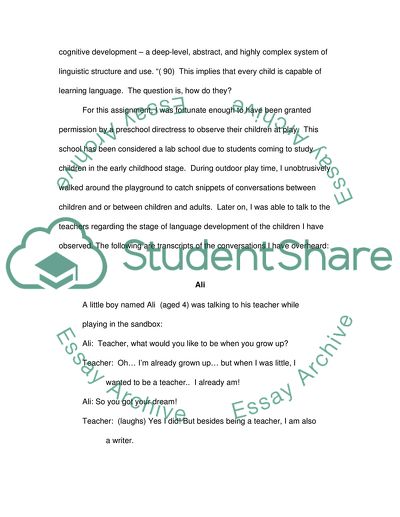Cite this document
(From the Mouth of Babes Assignment Example | Topics and Well Written Essays - 1750 words, n.d.)
From the Mouth of Babes Assignment Example | Topics and Well Written Essays - 1750 words. Retrieved from https://studentshare.org/social-science/1745484-language-play-is-an-important-aspect-of-everyday-communication-discuss-using-relevant-concepts-and-theories-from-the-e301-the-art-of-english-books-and-your-own-transcription-of-an-extract-of-authentic-everyday-spoken-language-data
From the Mouth of Babes Assignment Example | Topics and Well Written Essays - 1750 words. Retrieved from https://studentshare.org/social-science/1745484-language-play-is-an-important-aspect-of-everyday-communication-discuss-using-relevant-concepts-and-theories-from-the-e301-the-art-of-english-books-and-your-own-transcription-of-an-extract-of-authentic-everyday-spoken-language-data
(From the Mouth of Babes Assignment Example | Topics and Well Written Essays - 1750 Words)
From the Mouth of Babes Assignment Example | Topics and Well Written Essays - 1750 Words. https://studentshare.org/social-science/1745484-language-play-is-an-important-aspect-of-everyday-communication-discuss-using-relevant-concepts-and-theories-from-the-e301-the-art-of-english-books-and-your-own-transcription-of-an-extract-of-authentic-everyday-spoken-language-data.
From the Mouth of Babes Assignment Example | Topics and Well Written Essays - 1750 Words. https://studentshare.org/social-science/1745484-language-play-is-an-important-aspect-of-everyday-communication-discuss-using-relevant-concepts-and-theories-from-the-e301-the-art-of-english-books-and-your-own-transcription-of-an-extract-of-authentic-everyday-spoken-language-data.
“From the Mouth of Babes Assignment Example | Topics and Well Written Essays - 1750 Words”, n.d. https://studentshare.org/social-science/1745484-language-play-is-an-important-aspect-of-everyday-communication-discuss-using-relevant-concepts-and-theories-from-the-e301-the-art-of-english-books-and-your-own-transcription-of-an-extract-of-authentic-everyday-spoken-language-data.


